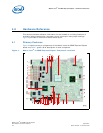
Mobile Intel
®
915GME Express Chipset
April 2007 Development Kit User’s Manual
Order Number: 317230-001US 29
Theory of Operation—Mobile Intel
®
915GME Express Chipset
Table 5 lists the power management states that have been identified for the Mobile
Intel
®
915GME Express Chipset Platform.
3.6.1 Transition to S1 or S3
If enabled, the transition to S1 or S3 from the full-on state can be accomplished in the
following ways:
• The OS performs the transition through software.
• Press the front panel power button for less than four seconds (assuming the OS
power management support has been enabled).
3.6.2 Transition to S4
“Wake on S4” (Suspend to disk) is controlled by the operating system.
3.6.3 Transition to S5
The transition to S5 is accomplished by the following means:
• Press the front panel power button for less than four seconds (if enabled through
the OS).
• Press the front panel power button for more than four seconds to activate power
button override.
3.6.4 Transition to Full-On
The transition to the Full-On state can be from S1, S3, or S5. The transition from S1 or
S3 is a low latency transition that is triggered by one of the following wake events:
• Power management timer expiration
• Real Time Clock (RTC) triggered alarm
• Power button activation
• USB device interrupt
• PME# assertion
• Mouse/Keyboard movement (Applies only to S1 Transition)
•AC power loss
Table 5. Mobile Intel
®
915GME Express Chipset Power Management States
State Description
G0/S0/C0 Full On
G0/S0/C2 STPCLK# signal active
G0/S0/C3 Deep Sleep: DPSLP# signal active
G0/S0/C4 Deeper Sleep: DPRSLP# signal active
G1/S3_HOT Suspend to RAM (all S3 rails are turned on except processor power rails)
G1/S3_COLD Suspend to RAM (all S3 rails are turned off)
G1/S4 Suspend to Disk
G2/S5 Soft Off
G3 Mechanical Off


















